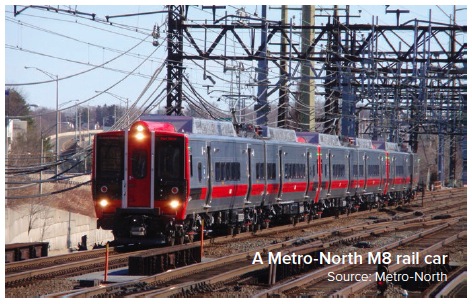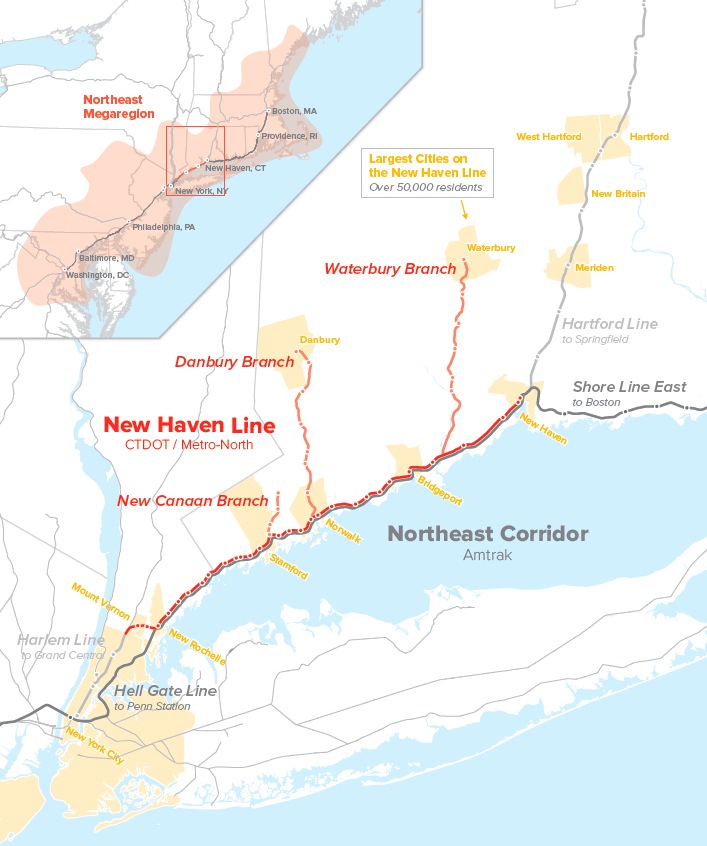REGIONAL PLAN ASSOCIATION
Executive Summary
 America’s busiest rail line is in trouble. The New Haven Line is a 60-mile stretch of track that carries commuters between New York City and Connecticut, and long-distance travelers throughout the Northeast. The line suffered two major outages in 2013, including a collision that injured 76 people and an electrical outage that shut down service on the line for more than two weeks. Delays and service disruptions due to aging infrastructure and critical repair work occur regularly, slowing travel for the line’s 125,000 daily passengers.
America’s busiest rail line is in trouble. The New Haven Line is a 60-mile stretch of track that carries commuters between New York City and Connecticut, and long-distance travelers throughout the Northeast. The line suffered two major outages in 2013, including a collision that injured 76 people and an electrical outage that shut down service on the line for more than two weeks. Delays and service disruptions due to aging infrastructure and critical repair work occur regularly, slowing travel for the line’s 125,000 daily passengers.
At the root of these incidents is old age. The line’s infrastructure has been allowed to deteriorate. The line’s owners, the states of Connecticut and New York, have made commendable progress improving the rail infrastructure they inherited in poor physical condition and under major funding constraints. But the funding shortfalls have forced both owners to defer long overdue capital investment needed for repairs and upgrades that are vital to protecting the line’s passengers. For example, the four movable bridges in Connecticut, all well beyond their replacement age, get stuck open several times a week, frequently delaying train traffic and causing ripple effects up and down the line.
At the current pace of investment of less than $200 million per year, it will take 20 more years to rebuild the New Haven Line’s aging structures and systems to achieve a state of good repair. In other words, for 20 more years passengers will be suffering through longer trip times and delays caused by the continuous track outages required to accommodate the reconstruction of critical components of the New Haven Line and by unexpected shutdowns in service. The nation’s busiest rail line in the nation’s most productive region cannot wait that long to return to full capacity.
The New Haven Line plays a vital role in supporting the nearly $3 trillion economy of the Northeast Megaregion. For over 160 years the line has been an essential commuter rail link between Manhattan, America’s predominant economic powerhouse; the northern suburbs of New York City; and the cities of southwestern and south central Connecticut. The New Haven Line is also a vital intercity connection on the Northeast Corridor linking Boston, New York, and Washington, D.C.
Getting Back on Track documents the key issues affecting the New Haven Line and outlines the critical capital investments needed for it to function once again as a reliable, four-track railroad. The State of Connecticut has budgeted nearly $1 billion for the line in its current 2013-2017 five-year capital plan. An analysis by Regional Plan Association found that an additional $3.6 billion is needed by 2020 to repair or replace aging and obsolete infrastructure. This will improve the long-term strength and reliability of the rail line, enabling it to continue fostering greater ridership, which generates other indirect benefits.
The emergency actions recommended in this report would help prevent future service disruptions and lay the groundwork for a long-term capital investment program that would improve the speed, frequency, reliability, connectivity and safety of New Haven Line rail service. The report also includes a set of policy recommendations that would speed the implementation of the projects and unlock federal funding to help pay for them, and identifies the line’s top investment priorities beyond 2020.
Download full version (PDF): Getting Back on Track
About Regional Plan Association
www.rpa.org
“Regional Plan Association is America’s oldest and most distinguished independent urban research and advocacy group. RPA prepares long-range plans and policies to guide the growth and development of the New York- New Jersey-Connecticut metropolitan region. RPA also provides leadership on national infrastructure, sustainability, and competitiveness concerns. RPA enjoys broad support from the region’s and nation’s business, philanthropic, civic, and planning communities.”
Tags: CDOT, Connecticut, Connecticut Department of Transportation, Metro-North, New Haven, New Haven Line, Regional Plan Association, RPA















 RSS Feed
RSS Feed